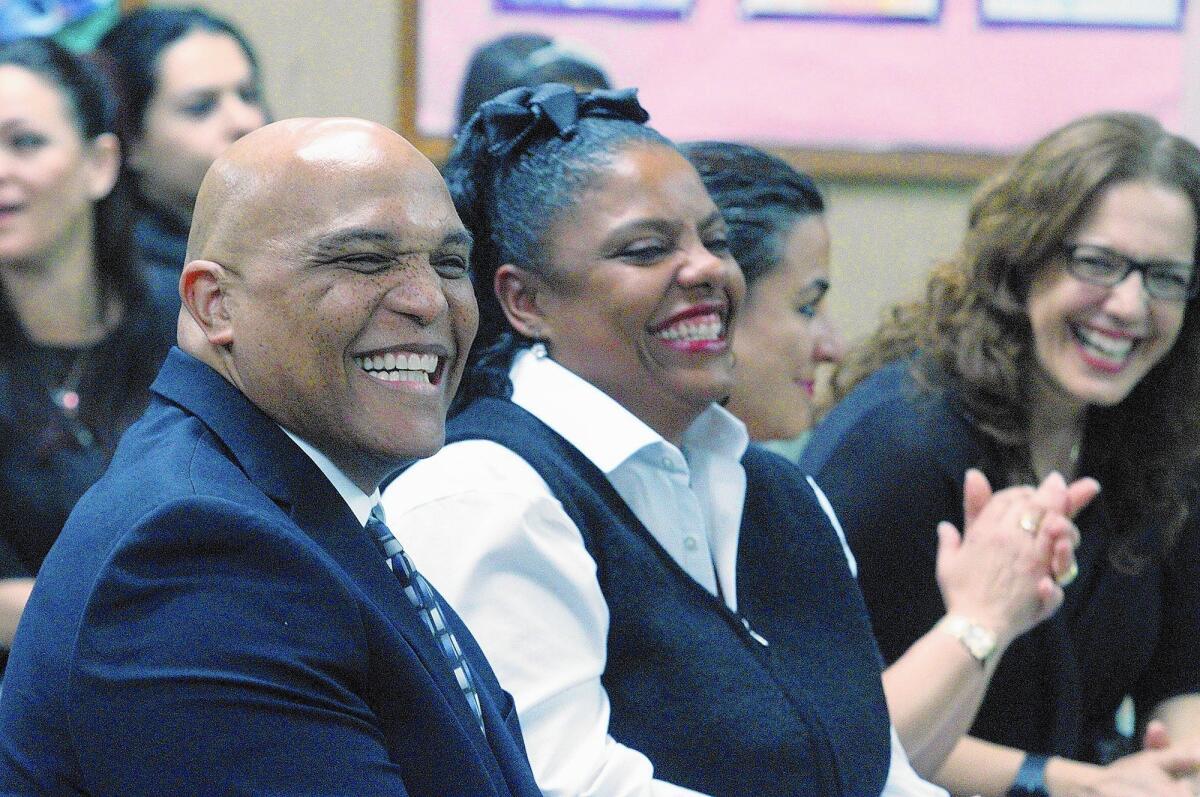Learning Matters: New GUSD superintendent faces immediate challenges

New Glendale Unified Superintendent Winfred Roberson Jr. and his wife Yvette are all smiles during the GUSD school board meeting Tuesday, Feb. 16, 2016. Roberson was hired to fill the vacancy left by Dick Sheehan, who was hired as superintendent of Covina-Valley Unified in May.
- Share via
It’s a new day for the Glendale Unified School District and its new superintendent, Winfred Roberson, who begins his work here this week. I wish him the very best as he acquaints himself with more than 26,000 students as well as teachers, other staff, parents and a host of individuals and organizations supporting our schools.
The work of public school superintendents has always been challenging, but it’s fair to say the challenges have intensified over the years as expectations for schools and their leaders have increased.
Communities want superintendents to do more despite diminished resources and increased competition for students’ time and attention. Even in relatively high-performing districts — perhaps especially in such communities — superintendents bear a good deal of the weight of parents’ high expectations for their children.
Read more from Joylene Wagner >>
The district has its own particular issues, too. One of the immediate challenges Roberson and the school board will face is the need to establish trustee voting areas, as required by the settlement of a lawsuit filed against the district under the California Voting Rights Act.
Glendale Unified is one of many districts that have made the change primarily to avoid the high costs of litigation. The first of two public hearings on the draft voting-area boundaries will be held during Roberson’s first school board meeting on Tuesday.
The hearings follow a series of meetings held last month at school sites across the district to provide information and gather public input.
For the record, I see both pros and cons in the change from at-large elections to representation by trustee areas.
On the one hand, all corners of the district, from north to south — including all of Glendale as well as unincorporated La Crescenta, Montrose, and, at least for now, the sliver of La Cañada called Sagebrush — will be represented by a school board member living in one of the five areas whose boundaries will soon be determined. Ideally, each area’s constituents will enjoy closer contact with their representative.
For school board candidates, campaigns should be more manageable and less expensive to conduct, because they will need to secure votes only from the area in which they live.
On the other hand, trustees elected by and presumed to be representing a single area may be less inclined to consider the needs of the district as a whole or the particular needs of students living across town.
In my two terms as an at-large board member from Adams Hill in south Glendale, I was expected to represent the whole district — the needs of the many English-language learners in my part of town as well as those of children from Crescenta Valley and north Glendale, some of whose parents were themselves proud Glendale Unified graduates.
NEWSLETTER: Stay up to date with what’s going on in the 818 >>
While I’m at it, I’ll also express my lingering disappointment that the lawsuit settlement did not effectively challenge the lack of connection between the legal claim, based largely on under-representation of Latino voters, and the remedy.
At a meeting I attended at Toll Middle School on March 17, demographer Doug Johnson confirmed there is no distinctly majority-Latino voting area he and his firm could identify from the district’s ethnically mixed neighborhoods. The outcome of the lawsuit, therefore, will likely not solve the problem that supposedly led to the change.
At a presentation in the Crescenta Valley, Johnson spoke further about the rather unusual findings of his company’s research on district voting patterns. “We have a weird situation in Glendale,” he was quoted as saying (Crescenta Valley Weekly, March 24). “Here… the lowest turnout precincts in the district are some of the wealthiest, up here in the unincorporated area. It’s a little bit of an oddity in that respect.”
Yes, Roberson has come to a very interesting district, with a variety of constituencies.
Another challenge he’ll face is the expansion of dual-language-immersion programs into middle and high schools, a matter of considerable discussion in the last year. The issue brings up a further odd fact to consider in the formation of trustee areas. Many of our neighborhood schools are not strictly neighborhood schools anymore.
Nine dual-language-immersion schools and two magnet elementary schools draw students from different attendance areas as well as from outside the district. According to information I received from Glendale Unified’s Sherry Kully, more than 23% of the district’s elementary students attend schools outside their attendance areas.
That means board members representing one neighborhood will continue making decisions affecting students and families who live elsewhere.
Whatever the eventual boundaries of the trustee voting areas, let’s hope the new superintendent and board are able to work together for the good of the whole district.
--
JOYLENE WAGNER is a past member of the Glendale Unified School Board. Email her at jkate4400@aol.com.
--
ALSO:
Intersections: Resolving heritage and history in La Crescenta
A Word, Please: The ease of using single quotation marks
Glendale PTA: A free program for college-bound students at GHS
